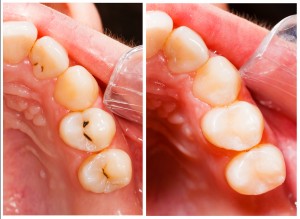Dental fillings have come a long way over the years. Traditional dental amalgams, which are mixtures of silver, mercury, copper and tin, have given way to composite filling, which are more popular these days because of their versatility and due to health concerns regarding mercury-based fillings. Resin composite fillings are made from plastic and ceramic compounds and have a lighter, tooth-like coloring.
Why Are Composite Fillings Used?
Since composite fillings are tooth-colored, they can be used on front teeth as well as back teeth, for a more natural appearance. In addition to filling in cavities, composites can be used to repair broken, chipped or otherwise damaged or worn teeth. Composites are a popular choice for doing minor repairs to improve the overall appearance of one’s teeth. This can result in greater self-confidence when speaking and smiling, in addition to repairing and strengthening damaged teeth.
Types of Dental Fillings
In today’s dental industry, several materials can be used for dental fillings. These include gold, porcelain, silver amalgam (mercury, silver, tin, zinc and copper), composite resin and glass ionomer. Each type of filling has its advantages and disadvantages in terms of time of procedure, durability and strength, appearance and cost. As you might imagine, one of the disadvantages of gold fillings is the expense. Composite fillings, while not as expensive as gold, are still pricier than silver amalgam. However, composites do not contain any mercury, if that is a concern. Although opinions differ, studies have found that mercury, as used in amalgam fillings, is not harmful. Some people, however, prefer to use composite fillings instead.
Advantages of Composite Fillings
A major benefit of composite fillings is that the color of the composite can be closely matched to the color of the patient’s teeth. This makes them a frequent choice for repair to teeth that are more visible. The composite material chemically bonds to the tooth’s structure, which means that they offer additional support. They’re very versatile, and can be used to repair teeth that are broken or chipped, in addition to filling in decayed areas. In tooth preparation, composite fillings often require less of the tooth to be removed than with amalgam fillings.
Disadvantages of Composite Fillings
There are some disadvantages of composite fillings. They tend not to last as long as amalgams — 5 years or more compared to 10 or 15 years with amalgam fillings. They might also not hold up as long to the pressure of chewing, especially if they’re used for larger cavities. The process takes a little longer than with amalgams, and additional visits to the dentist may be required if used as inlays or onlays. The composite material might get chipped, depending on where it was used, and composite fillings can cost considerably more than amalgam fillings.
The good news for dental patients today is that you have many choices, and composite fillings offer unique benefits for filling cavities and doing cosmetic repairs on your teeth for a beautiful smile.








Leave a Reply